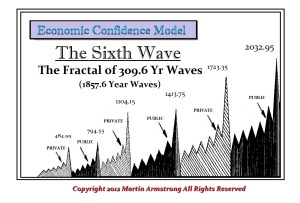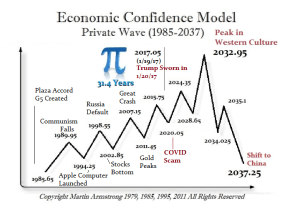The 80-Year Cyclical Theory v. the Economic Confidence Model
The concept of cycles is becoming accepted in Western culture. Recently, people have been honing in on what they deem the 80-year cyclical theory that marks a major shift in humanity. While this may be true as it takes a few generations to change society, they are not incorporating the additional nuisances associated with the true Economic Confidence Model.
The 80-year theory, also called the Strauss–Howe generational theory, believes that there are four 20-year cycles or turnings that build up to a cataclysmic event. For example, some are using 2024 as the starting point, which brings us back to 1944 when America was at the cusp of World War II. Going back an additional 80 years would bring us to 1864 – the US Civil War. Taking it back even further we arrive at 1784 when the Revolutionary War ended.
Now, absolutely everything is connected, and to garner the most accurate forecasts requires peering out at society and the global economy. The problem with the 80-year theory is that it was developed from a solely American viewpoint as it was designed to explain the history and future of the United States.
The Economic Confidence Model, at a basic level, sees waves of 8.6 years building in intensity amounting to six waves to construct a major long wave of 51.6 years. What you get at the end of these 51.6-year waves is very profound. After the 1774.95 peak, we end up with a revolution against the monarchy. The next wave peak in 1826.55 produced the Russo-Persian War, 1826-1828, Greek War of Independence, Battle of Monte Santiago between Brazil and Argentina, Mexican Constitution is formed, the Maryland Democratic Party begins creating the confrontation between the Democrats and Republicans (South v North) which sets the stage for the American Civil War in 1861, and even Thomas Jefferson and John Adams both died on the 4th of July 1826 (1826.50) marking the end of the generation of Enlightenment whereas the peak of the wave was July 19th. The next wave 1878 saw the Long Depression which was called the “Great Depression” until 1929-1932. The next wave peak of 1929,75 produced the takeover of the West by socialists. Then the next wave was 1981.35 which marked the peak in interest rates even to the day.
Each of these events shifted society as a whole. Capital concentration shifted in a profound way and changed nations. Nothing exists in isolation. The major wave will be 2032 and this will be followed by the shift from the West to the East in economic power.


